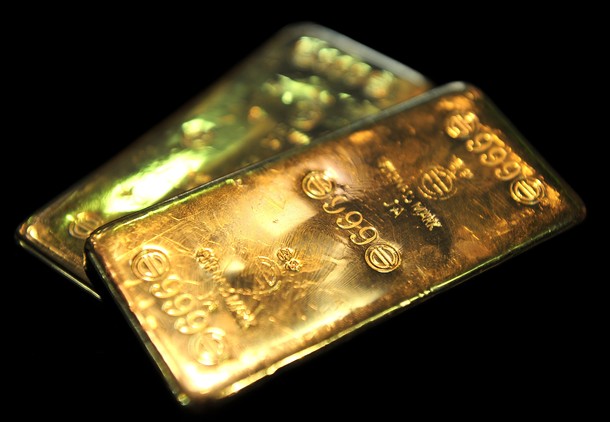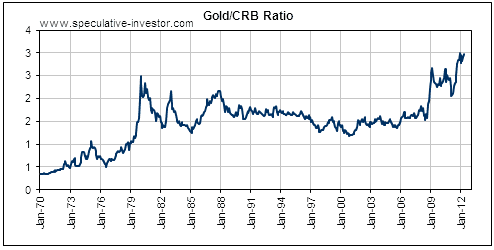Gold & Precious Metals
The Best Reason in the World to Buy Gold
on Saturday, 28 April 2012 15:51
Gordon G. Chang
Beijing is planning to avoid U.S. financial sanctions on Iran by paying for oil with gold. China’s imports of the metal are already large, and you can guess what additional purchases are going to do to prices.
On the last day of 2011, President Obama signed the National Defense Authorization Act for Fiscal Year 2012. The NDAA, as it is called, attempts to reduce Iran’s revenue from the sale of petroleum by imposing sanctions on foreign financial institutions conducting transactions with Iranian financial institutions in connection with those sales. This provision, which essentially cuts off sanctioned institutions from the U.S. financial system, takes effect on June 28.
The NDAA gives the president the power to waive the sanctions depending on the availability and price of supplies from non-Iranian sources. He can also exempt financial institutions from countries that have significantly cut back purchases of Iranian petroleum. Last month, the State Department announced waivers for Japan and ten European countries. China, which has received American waivers in the past under other Iran legislation, is now Tehran’s largest oil customer and investor as well as its largest trading partner. Given the new mood in Washington, Beijing cannot count on getting more exceptions in the future.
As the Wall Street Journal noted in early January, the sanctions are “an attempt to force other countries to choose between buying oil from Iran or being blocked from any dealings with the U.S. economy.” The strict measures put Chinese officials in a bind. They apparently believe their geopolitical interests align with those of Tehran, but their economy is becoming increasingly reliant on America’s.
To Read More CLICK HERE


Invest in Africa Now: Nana Sangmuah
Posted by Brian Sylvester of The Gold Report
on Saturday, 28 April 2012 15:45
Brian Sylvester of The Gold Report
Last year, Africa was the region that witnessed the strongest growth in gold-mining operations. In an exclusive interview with The Gold Report, Nana Sangmuah, managing director of research with Toronto-based Clarus Securities, expects that trend to continue and suggests some immediate smart investments in Ghana, Mali, Liberia and the Democratic Republic of the Congo.
The Gold Report: Gold consultancy GFMS, which is now owned by Thomson Reuters, recently published its 2012 Gold Survey. GFMS predicts that before the end of 2012, the yellow metal will likely reach above its all-time nominal high of $1,920/ounce (oz) in September 2011. The catalysts include inflation concerns and sovereign debt problems in Europe, especially Spain. What are your thoughts on these predictions and conclusions?
Nana Sangmuah: I agree with those predictions and the drivers. One thing that has been missing from the gold rally is inflation hedge demand. With the significant monetary easing that has occurred to drive a global recovery, inflation is definitely going to be an issue at some point. We haven’t seen inflation trade come into gold throughout these 10+ years. That’s the strong headwind that is going to move gold to another level.
TGR: The survey reported that mine production hit a record high in 2011, rising 2.8% year over year to reach 2,818 metric tons (mt). That marks the second straight year that gold production reached a new all-time high. Does that mean the theory of peak gold is dead?
NS: Not exactly. If you peel back the data over the past two years, the greater part of this growth has come from mines digging into their stockpiles and people revisiting old resources that previously were thought not to be economic but at these price levels look economic. There have been very few discoveries despite the fact that there’s been quite a lot of money spent on the exploration front. That rate of increase is not sustainable going forward. And the bigger picture still looks grim because the last big discovery of 5+ million ounces (Moz) is the Aurelian discovery—the Fruta del Norte deposit in Ecuador, which now belongs to Kinross Gold Corp. (K:TSX; KGC:NYSE)—from early in the 2000s. It takes on average at least five years to move from discovery into production, so we’re looking at a situation where the supply is not going to grow that much. If the investment demand is sustainable going forward, basically there won’t be enough ounces to feed that demand.
TGR: The GFMS survey also reported that new gold-mining operations contributed 47 mt of new gold supply, while Africa was the region that witnessed the strongest growth, increasing production by 51 tons (t) despite a 5 t drop in output from South Africa. Do you believe Africa will continue to lead the way in worldwide gold production?
To Read More CLICK HERE


All Signs Point To Upside For Copper, Goldman Sees Outperformance Vs. Oil
Posted by Sumit Roy
on Friday, 27 April 2012 16:17
Written by Sumit Roy
We examine the latest developments in the copper market.
Copper prices are on the rebound in recent sessions after tumbling throughout the first half of April. The industrial metal has shown a high correlation with other risk assets such as stocks, which have together been influenced by macroeconomic developments.
The heart of recent concern lies in the U.S. labor market. Today we learned that the number of people filing for unemployment claims in the U.S. fell by only 1,000 to 388K last week, leaving them near the highest level of the year.
In aggregate, the data this year has been positive; fluctuations in the data are normal and to be expected. That is the view the market seems to be taking given the recent rebound in prices. We tend to agree, although continued volatility until there is more clarity on the labor market is possible.
COPPER

As always, however, the outlook for China is the most important with regard to copper. After all, almost 40 percent of global demand for the industrial metal comes from the Asian giant.
Recent data indicate that growth in the country may be picking up. The PMI Manufacturing gauge hit the highest level in a year in March. April’s figures will be released on Monday.
To Read More CLICK HERE

Equities Will Catch Up to Higher Gold Price: Matt Badiali
Posted by Brian Sylvester of The Gold Report
on Thursday, 26 April 2012 1:49
Brian Sylvester of The Gold Report
Matthew Badiali Ongoing inflation pressures and China’s investments in the African gold supply chain point to a higher gold price, according to Matt Badiali of Stansberry & Associates. Bullion in all its forms belongs in every portfolio and when it comes to equities, investors have their choice of business models—dividend payers, prospect generators and royalty companies. In this exclusive Gold Report interview, Badiali outlines companies whose equities should catch up to the higher gold price.
Companies Mentioned: ATAC Resources Ltd. – Barrick Gold Corp. – Endeavour Silver Corp. – Franco-Nevada Corp. – Keegan Resources Inc. – MAG Silver Corp. – Newmont Mining Corp. – Pretium Resources Inc. – Riverside Resources Inc. – Royal Gold Inc. – Seabridge Gold Inc. – Silver Wheaton Corp.
The Gold Report: Matt, in the February 2012 edition of Stansberry’s Investment Advisory, Porter Stansberry predicted gold would hit $9,600 an ounce (oz) someday. How should investors protect themselves from this coming crisis?
Matt Badiali: In general, I agree with Porter’s thesis. Bullion—gold, silver coins or bars—should be part of everyone’s portfolio. It is one of the best anchors against inflation. Gold and gold stocks also are important holdings because as the value of paper money falls, the value of gold rises.
TGR: Stock prices have not gone up as much as the gold price. Will that trend continue?
MB: We have been in an odd scenario. If gold miners were T-shirt makers and the price of T-shirts went up, the market would buy the company to match the earnings. That has not happened for gold stocks.
Last year, the Market Vectors Gold Miners ETF (GDX:NYSE.A) was down 25% while the price of gold was up 15%. Looking at just the last three years, stocks were up 40% while the gold price rose 90%. So, in the short term, the Gold Miners ETF has underperformed gold.
Gold miners’ earnings have climbed dramatically, but their share prices have not followed suit. I believe gold miners will outperform the metal just because they have to rebalance.
TGR: What does the volatility in gold tell us?
MB: Generally speaking, the market wants a stable U.S. dollar. It rallies to dollars for all sorts of reasons. I think that is false faith.
So many new dollars have been printed that the value of all tangible things has to increase in response. For example, we all think $110/barrel oil is crazy expensive. But, relative to gold, oil has been less expensive over the last couple of years. The price of oil is falling in terms of real money, but going up in terms of dollars. That is a good indicator of how much new paper money has been printed.
TGR: What effect would higher interest rates have on junior miners? Can the increase in the gold price offset the greater cost of raising capital?
To Read More CLICK HERE


Is Gold Still Cheap?
Posted by Steve Saville
on Tuesday, 24 April 2012 15:14
By: Steve Saville
Below is an excerpt from a commentary originally posted at www.speculative-investor.com on 22nd April 2012.
We addressed the above question last year and arrived at the answer: no, gold left bargain territory long ago. We remain bullish on gold not because we think gold is still cheap, but because we expect it to get a lot more expensive.
This isn’t a “greater fool” game that we are playing, in that our belief that gold will become a lot more expensive over the years ahead isn’t based on the expectation that people will be silly enough to pay a much higher valuation in the future for an asset that is already over-valued today. It is, instead, a position based on the observation that the world’s most important central banks and governments remain committed to a course that ends in catastrophe for their economies and currencies. To put it another way, gold may well be expensive relative to the current economic backdrop, but it is cheap relative to what the economic backdrop will be 5 years from now if the current policy course is maintained. And at this stage there are no signs that the current policy course will not be maintained.
Evidence that gold is no longer in the bargain basement is provided by the following long-term monthly chart of the gold/commodity ratio. Relative to commodities in general, gold hit a 50-year high late last year. In fact, last December’s peak in the gold/commodity ratio could have been an all-time high. This tells us that the gold market has fully discounted the bad policies of the past several years. As an aside, it also tells us that the fabled gold market manipulators are doing a lousy job and should be fired (gold’s excellent performance over any reasonable investment timeframe is no doubt why promoters of gold-suppression theories tend to focus on timeframes that could only be of interest to daytraders).
To Read More CLICK HERE



-
I know Mike is a very solid investor and respect his opinions very much. So if he says pay attention to this or that - I will.
~ Dale G.
-
I've started managing my own investments so view Michael's site as a one-stop shop from which to get information and perspectives.
~ Dave E.
-
Michael offers easy reading, honest, common sense information that anyone can use in a practical manner.
~ der_al.
-
A sane voice in a scrambled investment world.
~ Ed R.
Inside Edge Pro Contributors

Greg Weldon

Josef Schachter

Tyler Bollhorn

Ryan Irvine

Paul Beattie

Martin Straith

Patrick Ceresna

Mark Leibovit

James Thorne

Victor Adair
